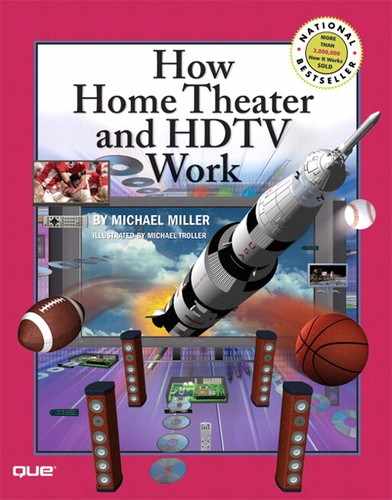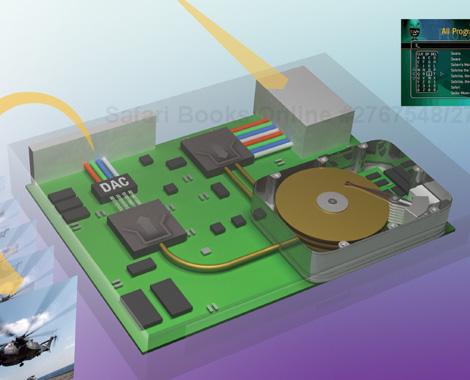THE picture on your new home theater system is only as good as the source material you feed to it. That source material can come from an over-the-air antenna (for broadcast television), a cable television signal, a direct broadcast satellite, or a variety of audio and video equipment. In fact, one of the nice things about a state-of-the-art home theater system is the variety of input devices you can use—each of which is typically used for different types of material.
Up until a few years ago, the primary video input device was a videocassette recorder (VCR). Most homes still have a VHS videocassette deck (Beta-format decks being long-since expunged from the market) and a healthy collection of videocassettes, either recorded at home or of the prerecorded variety. The problem with VCRs, however, and the reason they’re no longer widely used, is that the picture quality isn’t up to snuff—especially when compared to higher-quality sources (such as DVDs) and video displays. This is particularly apparent when playing a VCR on a new HDTV display; even the most tolerant viewer is apt to cringe at the soft, low-resolution VCR picture when compared to just about any other video source.
That doesn’t mean that video recorders don’t still have a place in your system. Particularly popular are the new breed of digital camcorders that let you record your own home movies and then edit them on your PC. The MiniDV format is far superior to the old VHS cassettes, recording digital picture and sound at least as good as what you find on commercial DVDs. Some high-end camcorders are even capable of recording in the high-definition video (HDV) format, which is as good as anything you’ll find on HDTV broadcasts.
Also popular, for quite different reasons, are digital video recorders (DVRs), also known as hard disk recorders (HDRs) or personal video recorders (PVRs). Regardless of which appellation you adopt, this is a device that functions like a mini-computer, complete with its own hard disk. Television programming is recorded onto the hard disk in digital format for crystal-clear playback. You can even use a hard disk recorder to pause “live” programming, essentially by feeding a live signal to the hard disk and then playing it back immediately from the hard disk, rather than watching the live signal directly. Hard disk recorders make recording easy (at least, a lot easier than with a VCR timer) by providing an electronic program guide (EPG) that displays upcoming programs in an easy-to-navigate grid. Just point to the show you want to record and click a button on the remote control; there aren’t any cumbersome timers to set!
For most viewers, the most popular video input device today is the DVD player. DVDs are like CDs in that they hold programming information digitally on a small disc that is read by lasers. DVDs are cheap, easy to use, and widely available; most come with a variety of extras (such as audio commentaries, movie trailers, and “making of”documentaries) to enhance the viewing experience. The picture quality is also very good, completely digital, and often enhanced for 16:9 aspect ratio TVs. It isn’t quite HDTV quality (not yet, anyway), but it’s as good as any standard definition source you can feed your system.
If you want high-definition programming via DVD, two next-generation disc formats are vying for your attention. The Blu-ray Disc and HD DVD formats both offer increased data storage to handle the heavy requirements of high-definition movies. You’ll need a new DVD player (or two) to play these formats, but the promise of 1080p movies on your home television is a big draw.
Of course, Blu-ray and HD DVD are competing and noncompatible formats, which means a big format war is at hand. Blu-ray promises up to 50GB of storage on a dual-layer disc and is backed by Sony, Philips, Apple, Pioneer, Samsung, Thomson, Twentieth Century Fox, and the Walt Disney Company. HD DVD promises up to 30GB of storage on a dual-layer disc and is backed by Toshiba, Sanyo, Paramount, Universal, and Warner. Both formats use 4.75” discs—the same diameter as the current DVD format.
Whichever format wins the high-definition DVD war, consumers will be getting much more capacity than is available on today’s DVDs: 30/50GB versus the current 8.5GB. That extra capacity is necessary to carry the high-definition picture and digital surround sound of HDTV programming. In fact, both Blu-ray and HD DVD can handle 1080p programming, which is higher quality that today’s 1080i HDTV broadcasts. For this reason, forward-thinking consumers will soon be adding high-definition DVD players to their home theater systems.
Finally, many consumers are adding personal computers to their home theater systems, in the form of digital media hubs or Media Center PCs. A home theater PC can take the place of multiple single-use devices, including CD players, DVD players, and hard disk recorders. Music and videos are stored on the device’s hard disk and then played back on command. Some media hubs even let you watch TV through the device and record television programming on the device’s hard disk. It’s a great audio and video source for any home theater system.

